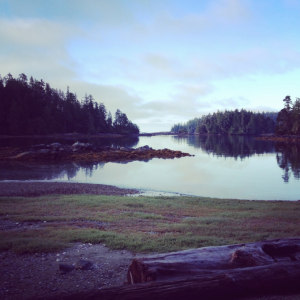Initially I was uncertain about my decision to attend an archaeological field school. With my interests in treaties and Aboriginal title, I had never seen archaeology as a direct part of my future, but my field school experiences so far may have changed that path. For two weeks our crew had the privilege of engaging Tseshaht community members, territory and history in the Broken Group Islands. Our crew camped at a Tseshaht reserve on Nettle Island and commuted daily to Jacques Island to conduct excavations at site of Hup’kisakuu7a. After brushing our teeth while enjoying a beautiful sunrise, our magnificent camp cook Wanda prepared a hearty breakfast that filled our tummies for the workday ahead. Excavations began slowly in the first week as my fellow students and I acquired new excavation techniques and faunal identification skills. My excitement took off when I uncovered our unit’s first in situ pieces of porpoise vertebrae. Further into our excavation, I was excited to retrieve through wet screening two seabird throat bones and a molar cap that likely came from a sea otter. Additionally, we had the opportunity to participate in two early morning intertidal excavations. In the intertidal we recovered fire-cracked rock, possible lithics and the inner ear bone of a whale. In addition to fieldwork, we had the pleasure of meeting members of the Tseshaht Beach Keepers, Parks Canada representatives from both the Pacific Rim and Gulf Islands parks and reputable archaeologists of the study area, such as Denis St. Claire and Ian Sumpter. Highlights of my experience include the daily boat rides between our camp and excavation site, visiting Parks Canada representative David Dick’s thoughtful words on respect and acknowledgement of territory and our evening trip to the fish traps of Jacques Island with Denis. While my time in the Broken Group was one that I will never forget, all good things must come to an end. From this experience I will take away first hand interactions with Tseshaht history and culture, new archaeological field techniques, a newfound comfort around boats, and a wonderful set of friends. My experience in the field demonstrated a tangible connection to place; a connection that cannot be absorbed through the text of treaty or in the words of the Constitution that relate to Aboriginal title, and for that, I am grateful. I would like to thank the Tseshaht First Nation for opening their home and hearts to my comrades and I for our time in their territory. Finally, I would like to thank our fearless leaders Iain & Ian (aka Keckles & Selly) for sharing their knowledge, excitement and patience with our group. I look forward to what is to come in Huu-ay-aht territory at the Bamfield Marine Sciences Center over the next three weeks!
